Green Juice Improving Health, and Vitality
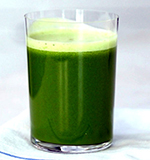 Most
people who have explored the wondrously wide avenues of self-healing
have heard about wheatgrass, and has been proven over
many years to benefit people in numerous ways: cleansing the lymph
system, building the blood, restoring balance in the body, removing
toxic metals from the cells, nourishing the liver and kidneys and
restoring vitality. One ounce of wheatgrass juice has the vitamin
and mineral equivalent of 2.2 pounds of fresh vegetables.
Most
people who have explored the wondrously wide avenues of self-healing
have heard about wheatgrass, and has been proven over
many years to benefit people in numerous ways: cleansing the lymph
system, building the blood, restoring balance in the body, removing
toxic metals from the cells, nourishing the liver and kidneys and
restoring vitality. One ounce of wheatgrass juice has the vitamin
and mineral equivalent of 2.2 pounds of fresh vegetables.
It contains most of the vitamins and minerals needed for human maintenance,
including the elusive B12. Many of the benefits of the juice
stem from the fact that it is a living food, which is a complete
protein with about 30 enzymes and is approximately 70% crude chlorophyll.
To be effective the juice has to be drunk immediately after juicing.
Anti-Mutagenic Power of the Chlorophylls
 George S. Bailey, Ph.D. - "Chlorophyll, the natural plant pigment
that lends its color to grass, leaves, and many of the vegetables
we eat, may play an important role in prevention of certain cancers.
Researchers in the early 1980s discovered that chlorophylls and
related chemicals can inhibit the ability of certain DNA-damaging
chemicals to cause mutations in bacteria. How might this kind of
"anti-mutagenic" activity be important in cancer prevention? Molecular
geneticists now know that most if not all human cancers carry mutations
in one or more genes that control the rates at which individual
cells divide, differentiate, or die. According to current thinking,
various combinations of mutations that upset this delicate balance
to favor uncontrolled cell growth can then enable this irreversibly
damaged cell to form a primary cancer in the lung, liver, blood,
bone, skin, or another body organ. Therefore, it seems at least
theoretically possible that the anti-mutagenic power of the chlorophylls
might allow them to inhibit or reduce the formation of cancers in
humans. Recent progress in our laboratory and elsewhere has brought
this promise closer to realization."
George S. Bailey, Ph.D. - "Chlorophyll, the natural plant pigment
that lends its color to grass, leaves, and many of the vegetables
we eat, may play an important role in prevention of certain cancers.
Researchers in the early 1980s discovered that chlorophylls and
related chemicals can inhibit the ability of certain DNA-damaging
chemicals to cause mutations in bacteria. How might this kind of
"anti-mutagenic" activity be important in cancer prevention? Molecular
geneticists now know that most if not all human cancers carry mutations
in one or more genes that control the rates at which individual
cells divide, differentiate, or die. According to current thinking,
various combinations of mutations that upset this delicate balance
to favor uncontrolled cell growth can then enable this irreversibly
damaged cell to form a primary cancer in the lung, liver, blood,
bone, skin, or another body organ. Therefore, it seems at least
theoretically possible that the anti-mutagenic power of the chlorophylls
might allow them to inhibit or reduce the formation of cancers in
humans. Recent progress in our laboratory and elsewhere has brought
this promise closer to realization."
One key question about wheatgrass is how long to wait after cutting
it before you consume it? Most people, taking their cue from Ann
Wigmore, say to take it immediately after cutting and juicing. However,
the hormone abscisic acid (ABA) is 40 times more potent 4 hours
after cutting the wheatgrass than it is at the time of cutting.
So the question boils down to this:
How important is ABA to treating
cancer compared to the other anticancer substances in wheatgrass?
"I see people go through this therapy everyday and I can tell
you, miracles happen." -Brian Clement, Director Hippocrates Health
Institute, West Palm Beach, Florida
"Why take these young grasses? Because you'll be giving yourself
a health elixir unlike anything you've ever experienced! The effect
these highly nutritious green drinks are having on all my patients,
especially my arthritis patients, is nothing short of amazing."
- Julian Whitaker, MD.
"Gary's platelet count rose every day for 7 days from 61,000
to 141,000 and the only thing we did differently was administer
wheatgrass. That's absolutely phenomenal and it's fully documented
on the hospital record." -Leonard Smith, MD., Cancer Surgeon
"Barley grass leaf extract dramatically
inhibits the growth of human prostatic cancer cells grown in tissue
culture. It may provide a new nutritional approach to the treatment
of prostate cancer." - Dr. Allan L. Goldstein, Ph.D, George Washington
Univ. Medical Center
"Wheatgrass juice is the nectar of rejuvenation, the plasma of
youth, the blood of all life. The elements that are missing in your
body's cells - especially enzymes, vitamins, hormones, and nucleic
acids can be obtained through this daily green sunlight transfusion"
Rev. Viktoras Kulvinskas - Rev. Viktoras Kulvinskas, MS, author of
Survival into the 21st Century
Wheatgrass and radiation
 Tests have been made which point to a chlorophyll (wheatgrass) rich
diet affecting the survival of experimental animals after lethal
doses of radiation. In 1950, Lourau and Lartigue reported that cabbage
supplement (chlorophyll) increases the resistance of guinea pigs to radiation.
Tests have been made which point to a chlorophyll (wheatgrass) rich
diet affecting the survival of experimental animals after lethal
doses of radiation. In 1950, Lourau and Lartigue reported that cabbage
supplement (chlorophyll) increases the resistance of guinea pigs to radiation.
Protection Against Radiation
Fallout (Radioiodine) A person exposed to "fallout" can suffer
from a myriad list of ailments, among them thyroid cancer. Thyroid
cancer, due to radiation poisoning, is caused by the uptake (through
inhalation or ingestion) of radioiodine (a radioactive isotope of
iodine). If a nuclear emergency should occur, be it from a reactor
or attack, the preferred way to block the uptake of radioiodine
is by making certain that the gland is already saturated with iodine.
Learn how to protect your thyroid with KI supplement.
Healing with Wheatgrass Juice
- Chlorophyll is the first product of light and, therefore,
contains more light energy than any other element.
- Wheatgrass juice is a crude chlorophyll and can be taken
orally and as a colon implant without toxic side effects.
- Chlorophyll is the basis of all plant life.
- Wheatgrass is high in oxygen like all green plants that
contain chlorophyll. The brain and all body tissues function
at an optimal level in a highly-oxygenated environment.
- Chlorophyll is anti-bacterial and can be used inside and
outside the body as a healer.
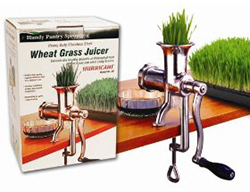
- Dr. Bernard Jensen says that it only takes minutes to digest
wheatgrass juice and uses up very little body energy.
- Science has proven that chlorophyll arrests growth and development
of unfriendly bacteria.
- Chlorophyll (wheatgrass) rebuilds the bloodstream. Studies
of various animals have shown chlorophyll to be free of any
toxic reaction. The red cell count was returned to normal within
4 to 5 days of the administration of chlorophyll, even in those
animals which were known to be extremely anemic or low in red
cell count.
- Farmers in the Midwest who have sterile cows and bulls put
them on wheatgrass to restore fertility. (The high magnesium
content in chlorophyll builds enzymes that restore the sex hormones.)
- Chlorophyll can be extracted from many plants, but wheatgrass
is superior because it has been found to have over 100 elements
needed by man. If grown in organic soil, it absorbs 92 of the
known 102 minerals from the soil.
- Wheatgrass has what is called the grass-juice factor, which
has been shown to keep herbivorous animals alive indefinitely.
- Dr. Ann Wigmore has been helping people get well from chronic
disorders for 30 years using wheatgrass.
- Liquid chlorophyll gets into the tissues, refines them and
makes them over.
- Wheatgrass Juice is a superior detoxification agent compared
to carrot juice and other fruits and vegetables. Dr Earp-Thomas,
associate of Ann Wigmore, says that 15 pounds of Wheatgrass
is the equivalent of 350 pounds of carrot, lettuce, celery,
and so forth.
- Liquid chlorophyll washes drug deposits from the body.
- Chlorophyll neutralizes toxins in the body.
- Chlorophyll helps purify the liver.
- Chlorophyll improves blood sugar problems.
- In the American Journal of Surgery (1940), Benjamin Gruskin,
M.D. recommends chlorophyll for its antiseptic benefits. The
article suggests the following clinical uses for chlorophyll:
to clear up foul smelling odors, neutralize strep infections,
heal wounds, hasten skingrafting, cure chronic sinusitis, overcome
chronic inner-ear inflammation and infection, reduce varicose
veins and heal leg ulcers, eliminate impetigo and other scabby
eruptions, heal rectal sores, successfully treat inflammation
of the uterine cervix, get rid of parasitic vaginal infections,
reduce typhoid fever, and cure advanced pyorrhea in many cases.
How much wheatgrass juice do I start with?
Start with one ounce a day with a small amount of water. As you
become accustomed, stop the water and work up to 6 ounces of wheatgrass
juice a day. Your energy level will be very high. Wheatgrass juice
should be mixed thoroughly with your saliva before swallowing. Drink
slowly one hour before meals. Wheatgrass juice is a powerful cleanser
and may cause nausea, through starting an immediate reaction with
toxins and mucus in the stomach.
Toxicity studies have shown that chlorophyll is absolutely non-toxic
when administered orally or intravenously to animals and humans.
The juice should be extracted either by chewing or utilizing a slow
action machine. Some manual juice extractors are very good for the
purpose. Grasses can be grown year round in any apartment or house,
city or country.
Why Do Dogs and Cats Eat Grass?
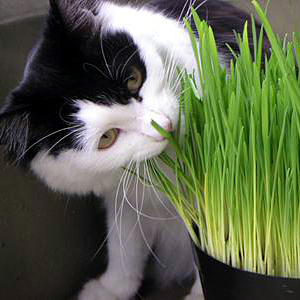 While it may be alarming to see Fido or Fluffy nibbling on the
front lawn or a houseplant, it shouldn’t be a cause for concern
unless the grass or plant was recently treated with pesticide, fertilizer,
or another poisonous chemical. Both dogs and cats from time to time
may take an interest in grass or similar substances, each for different
purposes that can actually benefit their bodies.
While it may be alarming to see Fido or Fluffy nibbling on the
front lawn or a houseplant, it shouldn’t be a cause for concern
unless the grass or plant was recently treated with pesticide, fertilizer,
or another poisonous chemical. Both dogs and cats from time to time
may take an interest in grass or similar substances, each for different
purposes that can actually benefit their bodies.
Dogs tend to self-medicate their bodies and regulate behavior
through occasional ingestion of plants, as the diets they often
receive in captivity are vastly different than what they would eat
in the wild. Dogs are not simply carnivorous, and can be often seen
hunting for roots and fruits. Since dogs evolved from wolves, in
the wild, wolves and dogs may eat an herbivore prey that they have
killed, and often first go for the stomach area of the carcass where
they will find roots, leaves and berries.
In domestication, a dog’s diet often consists of commercial dog
food, which contains synthetic preservatives, coloring and fillers.
Constant intake of such substances often leads to dog aggression,
when the dog’s discomfort exceeds tolerance levels. Over time, this
grain-based, high-carbohydrate diet can lead to digestive upset
and even diabetes. Again considering the evolutionary perspective,
wild dogs consume only minimal quantity of grains, in the shape
of already-digested paste and juices in the intestines of a seed-eating prey.
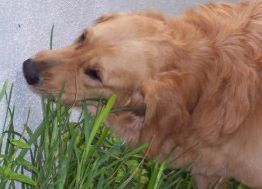 However, even though grass ingestion appears to have some redeeming
qualities for an dog, it can sometimes lead to vomiting. Some veterinary
experts suspect that ingestion could have been a catalyst for self-induced
vomiting to relieve stomach upset. Whether or not it was intentional,
it may have detoxifying properties for this very purpose.
However, even though grass ingestion appears to have some redeeming
qualities for an dog, it can sometimes lead to vomiting. Some veterinary
experts suspect that ingestion could have been a catalyst for self-induced
vomiting to relieve stomach upset. Whether or not it was intentional,
it may have detoxifying properties for this very purpose.
Cats often ingest plants and grass for this very same reason—mainly
to assist common bodily functions. Cats are avid groomers and seem
to spend hours preening and licking themselves. Unfortunately, this
usually means that they end up swallowing a lot of lose fur, which
accumulates in their stomach to form matted lumps called furballs.
While furballs are usually vomited or emitted in feces as part
of the body’s natural elimination process, a weak digestive system,
modern diet, sedentary lifestyles, or inadequate nutrition can interfere
with this process. To help stimulate this elimination, cats may
use grass as a laxative or to self-induce furballs, as it acts a
roughage to promote bowel movement or regurgitation. This not only
helps promote overall health as bodily functioning is restored,
but also relieves the discomfort associated with the blockage. It
may also be possible that the dog or cat just likes the taste! However,
it is important to discourage ingestion of grass or plants directly
after a meal, as unintentional regurgitation of dinner may result.
Wheatgrass for Your Pet's Health Testimonials
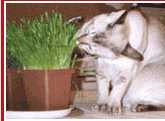 "Staff members of the Institute who lived with cats reported
their animals had less illness once they provided wheat grass regularly.
They noted that fur was more beautiful, and life spans longer. Formerly
arthritic older cats who could barely get in and out of the litter
box, were jumping on top of high surfaces. Immune systems in all
the cats grew strong and common sicknesses much more easily resisted.
Sores and strange lumps would disappear. Chronic conditions such
as upper respiratory problems would clear away for good. Keen observers
commented that cat's personalities and behavior changed. The cats became
"Staff members of the Institute who lived with cats reported
their animals had less illness once they provided wheat grass regularly.
They noted that fur was more beautiful, and life spans longer. Formerly
arthritic older cats who could barely get in and out of the litter
box, were jumping on top of high surfaces. Immune systems in all
the cats grew strong and common sicknesses much more easily resisted.
Sores and strange lumps would disappear. Chronic conditions such
as upper respiratory problems would clear away for good. Keen observers
commented that cat's personalities and behavior changed. The cats became
 calmer, and more "jungle cat-like" in their gait and mannerisms.
Making sprouts and growing wheat grass for your own cats is quick
and easy! Living foods will beautifully compliment a cat's raw meat
diet creating the perfect meal. Many different seeds and nuts may
be sprouted and added to your cat's food."
calmer, and more "jungle cat-like" in their gait and mannerisms.
Making sprouts and growing wheat grass for your own cats is quick
and easy! Living foods will beautifully compliment a cat's raw meat
diet creating the perfect meal. Many different seeds and nuts may
be sprouted and added to your cat's food."
"My 13 yr male cat is now walking around, does not have his mouth
infected and swollen face, and is carrying on with his appetite...
Wheatgrass changed his energy level in 20 minutes, he began eating,
the swelling and infection went away in 2 days, his respiratory
and sinus dis-ease (due to chemical medicine he was prescribed and
I stupidly gave him when I don't even use them for myself)was gone
in those 2 days and my love is now back to normal.I 'm also taking
wheatgrass and feel great. With my cat I have to put it in a dropper
cause he just does not like the taste but what the heck a grab by
the neck everyday stimulates his senses and circulation.
Thanks again for your website." Mayan Camera in NY
Cat Health Boosted Green Juice
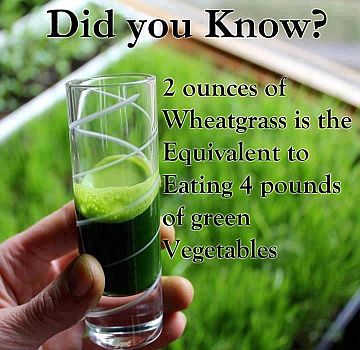 If you have not already gotten a copy, please check out Dr. Jensen's book, Foods that Heal.
It efficiently presents in layman's terms how to heal using food and juice combinations
based on the chemical elements contained therein. Of course, in
pets, you just have to give very small portions (literally, 1/2-teaspoon
amounts) to see results. And because the right combination of juices
will taste good to them, animals willingly take the juice mixed
into their foods -- resulting in less stress on both owner and pet.
So now my cats get vegetable-only juice and the dogs get the pulp
-- so there's no waste -- all are getting healthy, and I'm saving
$$$ on vet bills."
If you have not already gotten a copy, please check out Dr. Jensen's book, Foods that Heal.
It efficiently presents in layman's terms how to heal using food and juice combinations
based on the chemical elements contained therein. Of course, in
pets, you just have to give very small portions (literally, 1/2-teaspoon
amounts) to see results. And because the right combination of juices
will taste good to them, animals willingly take the juice mixed
into their foods -- resulting in less stress on both owner and pet.
So now my cats get vegetable-only juice and the dogs get the pulp
-- so there's no waste -- all are getting healthy, and I'm saving
$$$ on vet bills."
"...once they provided the cats with wheat grass regularly,
formerly arthritic older cats who could barely get in and out of
the litter box, were jumping on top of high surfaces.
Immune systems in all the cats grew strong and common sicknesses much more easily
resisted. Sores and strange lumps would disappear. Chronic conditions
such as upper respiratory problems would clear away for good.

How to Grow Wheatgrass At Home
 Here is how I grow my wheatgrass:
Here is how I grow my wheatgrass:
1). I soak about 3-4 cups of hard winter wheatgrass seeds
(preferably organically grown) for 3 to 8 hours in water. I add
a couple of drops of organic vinegar to acidify the water which
keeps fungus or mold from forming. Sprouters believe that all the
nutrient is in the seed. For the first 4-5 days young plants can
grow in anything because they are getting their nutrients from the
seed. They can grow in anything, even shredded paper. After 4-5
days the plants have developed roots which begin seeking the soil
for nutrients to continue to grow into healthy plants. Wheatgrass
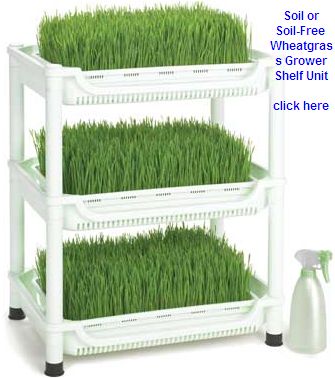 minerals,
grow 2-5 days without the needed additional nutrients. I add one
tablespoon of Sole per gallon of water, or one teaspoon of fulvic minerals or
marine phytoplankton, rich with over 70 naturally occurring organic
trace minerals and elements. Organic fulvic acids are created by
micro-organisms in the soil, for the purpose of transporting minerals
and nutrients from the soil into a plant. Wheatgrass grown with
fulvic acid burst with health and nutrients which benefit us.
minerals,
grow 2-5 days without the needed additional nutrients. I add one
tablespoon of Sole per gallon of water, or one teaspoon of fulvic minerals or
marine phytoplankton, rich with over 70 naturally occurring organic
trace minerals and elements. Organic fulvic acids are created by
micro-organisms in the soil, for the purpose of transporting minerals
and nutrients from the soil into a plant. Wheatgrass grown with
fulvic acid burst with health and nutrients which benefit us.
2. I drain the water and place the seeds in a colander. I
rinse the seeds 2 to 3 times a day with the original water that
the seeds soaked in. This prevents the seeds from drying out and
from forming mold. NOTE: I do NOT wrap
the seeds in the colander with plastic. I leave it exposed to air
3. I Line up a nursery growing tray with a sheet of paper
and spread 1/4 to 1/2 inch of potting soil.
4. As soon as the seeds begin to sprout in the colander,
they are ready to be moved to the growing tray. I spread the seeds
in the growing tray over a 1/2 inch of potting soil. There is no
need for fertilizer. I do not cover the seeds with
soil. I place the tray on a plastic sheet in front of a window.
5. I place a second empty tray on top of the seed tray upside
down (like a roof) and I cover the top tray with a wet towel. This
will protect the seeds and sprouts from drying out. I make sure
that the towel is kept wet or moist all the time.
6. As soon as the grass is tall enough to hit the roof of
the top tray, I remove that top tray and towel.
7. During the first 2 or 3 days, the tray needs watering everyday, but not too much or the roots will rot.
Wheatgrass can grow year-round but it doesn't grow well in the hot
summer. It grows best in cooler weather. During summer, I keep
my wheatgrass trays in the shade with good ventilation to prevent
overheating and to prevent mold or fungus.
The Organic Barley Grass Growing Kit is the complete organic
and simple set up! Each kit starts you out with enough organic barley
seed, organic soil, organic minerals, and growing trays to grow
five trays of Barley Grass- yielding at least 60 ounces of barley
juice (1 month supply at 2 ounces a day). Each Barley Grass kit
comes with simple easy to follow growing and harvesting instructions.
The growing instructions teach you to grow barley grass in the most
nutritious and simple way possible! To insure the highest possible
mineral content and barley grass yield, we have included an organic
forest compost mixture and Azomite, an organic all natural mineral
that insures that your barley grass contains all of the trace minerals required by the human body
for maximum health. Each Kit Includes: 5 21''x10'' Growing Trays.These
durable black growing trays can be reused over and over again. Drain
 holes and easy portable size make these trays perfect for growing
grass even in your own kitchen. Each tray of barley grass will yield
12 to 14 ounces of juice.5 Measured bags (5 lbs) Certified Organic
Barley Grass Seed 2 8-Quart Bags of Organic Soil Mix Forest Based
Compost, Completely Animal Free !Enough soil to grow 5-6 flats of
wheatgrass, barley grass or sunflower greens.
holes and easy portable size make these trays perfect for growing
grass even in your own kitchen. Each tray of barley grass will yield
12 to 14 ounces of juice.5 Measured bags (5 lbs) Certified Organic
Barley Grass Seed 2 8-Quart Bags of Organic Soil Mix Forest Based
Compost, Completely Animal Free !Enough soil to grow 5-6 flats of
wheatgrass, barley grass or sunflower greens.
This mixture is created using organic compost, and peat moss. This mix will allow you to
increase your growing yield as well as increase the nutrition of
your grass. Compost your spent soil flat and use it over and over. Azomite has 67 major and trace elements, so its name
means "A to Z Of Minerals Including Trace Elements." Typical analysis
shows every element that's beneficial to plants and animals, and
other elements (micro-nutrients) scientists believe essential. Barley
Grass Growing and Juicing Instructions Free growing technical support.

Wheatgrass Juice - Gift of Nature
The solid content of juice made from wheatgrass is 70 percent
chlorophyll. Chlorophyll is often referred to as "the blood of plant
life" and has almost the same chemical structure as haemoglobin
(oxygen transport molecules in red cells in human blood), according
to studies done in 1911. The difference between the two is that
in human blood the metallic element of the haemoglobin is iron,
while in chlorophyll this atom is magnesium. Chlorophyll goes into
the red blood cells immediately. The red cell count was returned
to normal within 4 to 5 days of the administration of chlorophyll
in animals which were known to be extremely anaemic.
Chlorophyll was praised in the 1940 American Journal of Surgery by Benjamin
Gruskin, M.D. for its antiseptic benefits. The article recommends
the following clinical uses for Chlorophyll - to clear up foul-smelling
odours, neutralise infections, heal wounds, hasten skin grafting,
cure chronic sinusitis, overcome chronic inner ear inflammation
and infection, reduce varicose veins and heal leg ulcers, eliminate
impetigo and other scabby eruptions, heal rectal sores, successfully
treat inflammation of the uterine cervix, get rid of parasitic vaginal
infections, reduce typhoid fever, and cure advanced pyorrhoea in
many cases.
Nutritionist Bernard Jensen lauds the virtues of Chloryphyll
because of the magnetic and electrical quality of the raw enzymes
it contains. According to Dr. Earp-Thomas, 15 pounds of fresh wheatgrass
is equivalent in nutritional value to 350 pounds of the choicest
vegetables.
Dr.Birscher, a research scientist, called chlorophyll "concentrated
sun power." He says chlorophyll increases function of the heart,
affects the vascular system, the uterus, the intestine and the lungs.
According to Dr. Birscher, nature uses chlorophyll as a body cleanser,
rebuilder and neutralizer of toxins. Wheat grass juice can dissolve
scars that are formed in the lungs from breathing acid gasses. The
effects of carbon monoxide is minimized since chlorophyll increases
hemoglobin production. Wheat grass juice helps to reduce high blood
pressure as the juice helps to reduce toxins from the body and gives
the blood iron which helps circulation. It purifies the blood.
A small amount of wheatgrass in the human diet helps prevent
tooth decay. Tooth decay is the result of other degenerative changes
in the body. Gargle with wheatgrass juice for toothaches. Gargle
with wheatgrass juice for a sore throat.
"Taking wheatgrass juice we will feel the difference in our sense
of strength, health, spirituality, endurance and wellbeing. Research
scientist Dr Birscher called chloryphyll "concentrated sun power.
Chloryphyll increases the function of the heart, affects the vascular
system, the intestines, the uterus and the lungs"
Caldera Greens,
are a premium source of organically grown,alkaline-forming,
enzymatically-alive, super foods
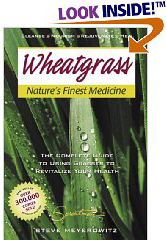 which help promote proper pH balance and proper immune function.
which help promote proper pH balance and proper immune function.
Wheatgrass has broad effectiveness, but its three
most therapeutic roles are: blood purification, liver detoxification,
and colon cleansing. As a food it is very nourishing and restorative
with such a complete range nutrients that it can, by itself, sustain
life. Wheatgrass earned its reputation from people with terminal
illnesses who took it at the eleventh hour of their lives, after
conventional medicine left them with no hope. But you can take it
as part of a long range prevention and health maintenance program.

Healing With Barley Grass
Some people who try grass juice find that they just cannot tolerate wheatgrass
juice. It is extremely detoxifying and makes some people nauseous
every time they drink it. These people may find that they can tolerate
barley grass juice. It is milder, although quite bitter, compared
to the sweetness of wheatgrass juice."
Barley grass is one of the green grasses. The young barley leaves
have a tremendous ability to absorb nutrients from the soil. When
barley leaves are 12-14 inches high, they contain all the vitamins,
minerals, and proteins necessary for the human diet, plus chlorophyll.
Barley contains a multitude of vitamins and minerals. Its juice
is seven times richer in Vitamin C than an equivalent weight of
oranges, five times richer in iron than spinach, ten times richer
in calcium than milk, is a significant source of Vitamin B-12, and
contains 15 times as much protein as an equivalent amount of milk.
A research pharmacologist from Japan, Dr. Yoshihide Hagiwara,
M.D believes that the key to the nutritive value of this supplement
is not just the nutrient content of the concentrated extract, but
its biochemical form which promotes more effective assimilation.
What really sets this powdered barley juice apart from other food
supplements, he says, are the thousands of live enzymes. The anti-aging
enzyme superoxide dismutase (SOD) is one of these. SOD aids in digestion
and metabolism by helping to disperse vitamins and minerals into
the blood stream to be absorbed by the body. Dr. Richard Cutler,
a biophysicist at the National Institute of Aging has shown that
the life span of many mammalian species, including man were found
to be directly proportional to the amount or SOD contained in the
cells. The animals with the longest life spans and man were found
to have the highest levels of SOD. SOD acts as a cellular anti-oxidant,
protecting against radiation and chemical free-radicals from pollution,
as well as acting as an anti-inflammatory agent and preventing cellular
damage following heart attacks.
 Dr. Hagiwara and Biologist Dr. Jasuo Hotta, a specialist of gene
engineering at the University of California at La Jolla, found that
when powdered barley juice was added to damaged cells, the DNA within
the cells repaired itself twice as quickly as DNA in cells receiving
none. Current theories are that both cancer and aging result when
genes fail to repair themselves. Moreover, when the barley juice
supplement was added to cells before they were subjected to radiation
and a carcinogen, Hotta says the repair rate was easily three times
as fast as normal." Thus, Dr.Hagiwara claims, the findings may eventually
help to prevent cancer, aging, or both. Experiments showing the
ability of powdered barley juice to repair damaged cells, neutralize
the effects of carcinogens and radiation, and retard the aging process
have all been done on laboratory cell cultures and animals. While
many people report improvement in a wide variety of physical problems,
no controlled tests have been done on humans. The improvements noticed
are the effects o[ detoxifying the body and providing the proper
nutritional elements in a form readily absorbed by the body.
Dr. Hagiwara and Biologist Dr. Jasuo Hotta, a specialist of gene
engineering at the University of California at La Jolla, found that
when powdered barley juice was added to damaged cells, the DNA within
the cells repaired itself twice as quickly as DNA in cells receiving
none. Current theories are that both cancer and aging result when
genes fail to repair themselves. Moreover, when the barley juice
supplement was added to cells before they were subjected to radiation
and a carcinogen, Hotta says the repair rate was easily three times
as fast as normal." Thus, Dr.Hagiwara claims, the findings may eventually
help to prevent cancer, aging, or both. Experiments showing the
ability of powdered barley juice to repair damaged cells, neutralize
the effects of carcinogens and radiation, and retard the aging process
have all been done on laboratory cell cultures and animals. While
many people report improvement in a wide variety of physical problems,
no controlled tests have been done on humans. The improvements noticed
are the effects o[ detoxifying the body and providing the proper
nutritional elements in a form readily absorbed by the body.
"Many people when they hear about the living foods program of
recapturing health and regenerating the body instinctively know
that it is true. I had had chronic fatigue for many years and had
tried almost every herb, vitamin, and healing modality available
in health food stores. Later, I attended the Ann Wigmore
Institute in Boston and then began growing wheatgrass commercially
for juice bars and health food stores. At first, I didn’t radically
alter my diet – the main thing I did was faithfully drink the wheatgrass
juice every day. I noticed a great increase in energy, enough to
allow me to operate my business, which involved working ten to twelve
hours per day."
Recently research has unveiled a wealth of other possible benefits
of green barley leaves. Extracted compounds have found to have hypercholesteromic,
anti-inflammatory, and anti-ulcer properties. A new antioxidant,
2"-0-GIV, has been isolated and reported to have antioxidant activity
equal to or superior to vitamin E. Finally, studies have shown that
when green barley juice is added to injured cells, the cells' DNA
repairs itself rapidly. This may contribute to preventing the changes
that often lead to cancer, rapid aging, and cell death.
Healing with Alfalfa
Daniel B Mowry, Ph.D. - “Alfalfa contains an enormous
quantity of nutrients, in a form that is easily digested and assimilated
by man. It is up to 50% protein, contains a good quantity of beta-carotene,
chlorophyll and octacosanol. Herbalists have used alfalfa for many
different purposes. Most of these applications bear one-to-one correspondence
to the various nutrients in the plant. The one word that keeps appearing
is “tonic”. The plant is a kidney tonic, prostatic tonic, reproductive
tonic, musculoskeletal tonic, glandular tonic and so forth. Alfalfa
has traditionally been one of the best herbal treatments of arthritis,
gout and rheumatism. Alfalfa has a proven cholesterol lowering effect.
Steroidal anti-inflammatory action is suggested by its content of
plant steroids, and by some research that found an estrogenic effect
on ruminants (grazing animals). Alfalfa has also been shown to possess
antibacterial action against gram negative bacteria (such as Salmonella
typhi), and it contains at least one protein with known antitumor activity.”
Dr. Donna Schwontkowski- "Alfalfa has been used for centuries
by people world-wide for overall support and rejuvenation. Because
of its deep root system, alfalfa is a rich source of the minerals
calcium, magnesium, phosphorous, iron, potassium and trace minerals.
Specifically, it is one of the best sources of protein and is very
high in chlorophyll, carotene, the Vitamins A, D, E, B-6 and K,
and several digestive enzymes. This may be why it is said to help
reconstitute bone and when fresh, is beneficial for rickets. Alfalfa
is one of the most studied plants. Research suggests that it may
inactivate dietary chemical carcinogens in the liver and small intestine
before they have a chance to do the body any harm. It is commonly
used for bladder infections. Used on the skin or in the bath, Alfalfa
is good for fatigue and muscle tenderness. It is also used to reduce
pain and inflammation of rheumatism and arthritis. Alfalfa is used
as an appetite stimulant, vitality augmenter (tonic), a digestive
stimulant, for insomnia, and to relax the nervous system."

Greens, Phytonutrients and Phytochemicals
What are phytochemicals? In the Greek language, the word 'phyto'
means plant. Phytochemicals are, by definition, any biologically
active compound derived from plants. They function as the plant's
immune system, defending against exposure to diseases and viruses;
determine plant color and taste; and aid the many biological tasks
plant organisms must carry out to survive. Thousands of phytochemicals
are found in plants, and humans have only recently begun to study
the molecular structure of these valuable food compounds.
Examples of phytochemicals are carotenoids, flavonoids, plant
sterols, polyphenols, lignans, sulfides, curcumins, saponins, coumarins,
terpenoids, phthalides, and many more. On-going research continues
to provide new insights into what they are and how they aid in the
preservation of human health. According to Dr. Bruce West, Phytonutrients
are the "raw material" nature provides for your body to cure itself.
Derived from living things, primarily plants (phyto is Greek for
plant), phytonutrients are a combination of naturally occurring
phytochemicals, vitamins, minerals, trace elements, and enzymes.
Also known as Super Green Foods or Green Super Foods. PhytoNutrients
provide the synergistic combination of all of natures raw materials
for healing the body - not just isolated and artificially created
products.
Why do we need 'greens'? Greens are our most important foods
because they provide us with all of the essential components of
health. They are our foods, as well as our medicines. Where green
plants cannot grow, we cannot live.
Making the Transition to a Diet Which Contains Not Only Enzymes but
the Essential Fatty Acids
"Many people when they hear about the living foods program of
recapturing health and regenerating the body instinctively know
that it is true. When I first heard about Ann Wigmore and wheatgrass
juice, I became enthusiastic about it, bought an electric wheatgrass
juicer and began first purchasing and then growing my own wheatgrass.
I had had chronic fatigue for many years and had tried almost every
herb, vitamin, and healing modality available in health food stores.
Later, I attended the Ann Wigmore Institute in Boston and then began
growing wheatgrass commercially for juice bars and health food stores.
At first, I didn’t radically alter my diet – the main thing I did
was faithfully drink the wheatgrass juice every day. I noticed a
great increase in energy, enough to allow me to operate umy business,
which involved working ten to twelve hours per day. During the years
of being in business, I noticed the reactions of people when they
started on wheatgrass juice. Some who started wheatgrass juice daily,
didn’t change their diets and found the juice so detoxifying that
they were unable to continue taking it for very long. The reaction
they got was an aversion to the juice—enough to make them nauseous.
(The solution to this is to 1) change the diet, and /or 2) cut back
on the amount taken each day or 3) drink barley grass juice instead.
4)Also there is a possibility that mold on the grass causes the
nausea. This can be alleviated by cutting the grass and power rinsing
before juicing."